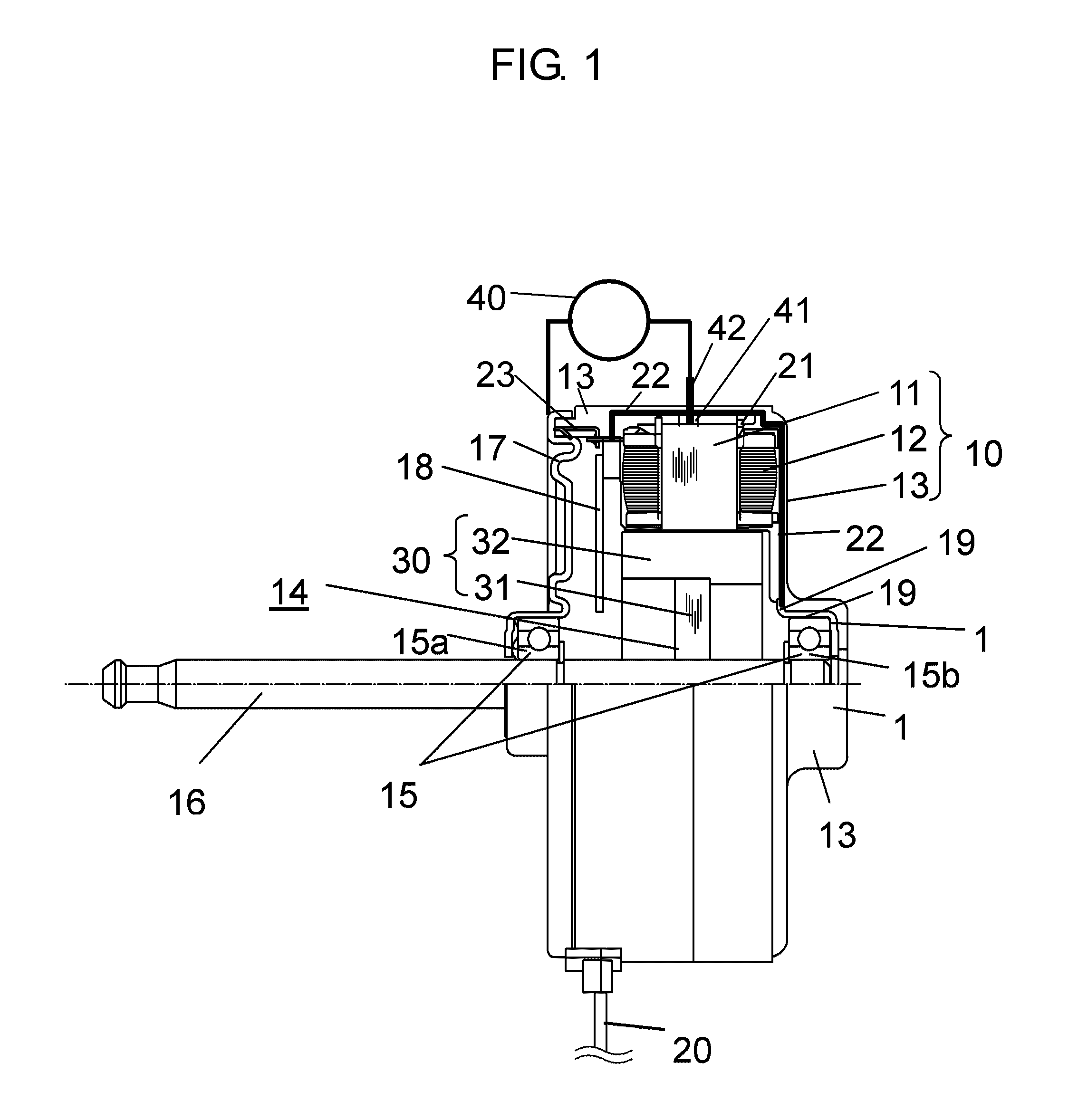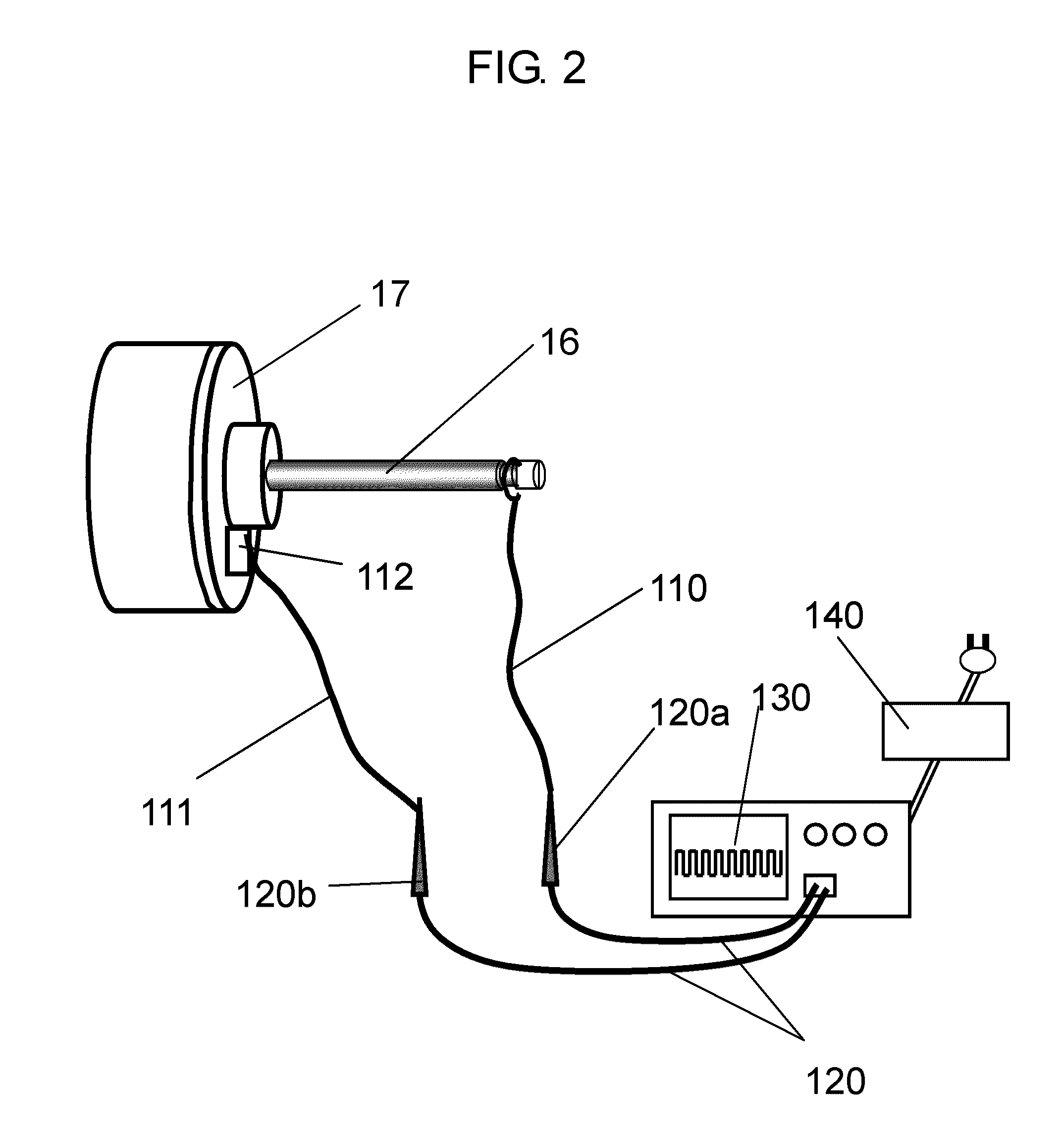Motor and electric device using same
a technology of electric devices and motors, applied in the direction of windings insulation materials, dynamo-electric machines, supports/encloses/casings, etc., can solve the problems of abnormal sound, deterioration of conductivity of conductive lubricant agents, and corrosion of electric bearings, so as to reduce the shaft voltage of bearings and reduce the impedance
- Summary
- Abstract
- Description
- Claims
- Application Information
AI Technical Summary
Benefits of technology
Problems solved by technology
Method used
Image
Examples
embodiment 1
[0039]FIG. 1 is a structural diagram showing a cross section of a brushless motor according to Embodiment 1 of the present invention. In the present embodiment, an example of a brushless motor that is a motor to drive a blowing fan mounted for an air conditioner serving as an electric device will be described. In the present embodiment, an example of an inner rotor type brushless motor in which a rotor is rotatably arranged on an inner circumference side of a stator will be described.
[0040]In FIG. 1, on stator iron core 11, stator winding 12 is wound on insulator 21 serving as a resin to insulate stator iron core 11. Stator iron core 11 is molded together with another fixing member with insulating resin 13 serving as a molding material. In the present embodiment, the members are integrally molded to configure stator 10 having a generally cylindrical shape as an outer shape.
[0041]Inside stator 10, rotor 14 is inserted via a gap. Rotor 14 has disk-like rotating body 30 including rotor...
example 1
[0060]In the configuration shown in FIG. 1, dielectric elements having capacitances of 10 pF, 50 pF, 100 pF, 150 pF, and 300 pF were connected in series between bracket 17 and connection pin 42 as capacitors 40 to measure shaft voltages. As the dielectric element, an air variable capacitor (variable capacitor) the capacitance of which can be arbitrarily adjusted was used.
[0061]As magnet 32 held by rotor 14, a ferrite resin magnet was used. As bearing 15, 608 available from Minebea Co., Ltd. (grease having a consistency of 239 was used) was used.
[0062]FIG. 2 is a diagram showing a method of measuring a shaft voltage in Example 1. A DC stabilized power supply was used in a shaft voltage measuring state. The measurement was executed under the same operating conditions in which power supply voltage Vdc of a stator winding was set to 391 V, power supply voltage Vcc of the control circuit was set to 15 V, and a rotating speed was set to 1000 r / min. The rotating speed was adjusted by contr...
example 2
[0078]In Example 2, evaluations were performed while changing the types of magnets 32 held by rotor 14. The evaluations were performed by using a ferrite resin magnet and a neodymium magnet as magnets 32. In the configuration as shown in FIG. 1, when rotor 14 holds a ferrite resin magnet, a dielectric element having capacitance of 100 pF was connected in series between bracket 17 and connection pin 42 as capacitor 40. When rotor 14 holds a neodymium magnet, a dielectric element having capacitance of 150 pF was connected in series between bracket 17 and connection pin 42 as capacitor 40. The brushless motors of the two types were manufactured and evaluated by the same method as that in Example 1.
[0079]In order to check an electric corrosion suppressing effect in the above specification, the brushless motors were prepared, and the electric corrosion suppressing effects were checked by an electric corrosion endurance test.
[0080]The electric corrosion endurance test was executed under t...
PUM
 Login to View More
Login to View More Abstract
Description
Claims
Application Information
 Login to View More
Login to View More - R&D
- Intellectual Property
- Life Sciences
- Materials
- Tech Scout
- Unparalleled Data Quality
- Higher Quality Content
- 60% Fewer Hallucinations
Browse by: Latest US Patents, China's latest patents, Technical Efficacy Thesaurus, Application Domain, Technology Topic, Popular Technical Reports.
© 2025 PatSnap. All rights reserved.Legal|Privacy policy|Modern Slavery Act Transparency Statement|Sitemap|About US| Contact US: help@patsnap.com



